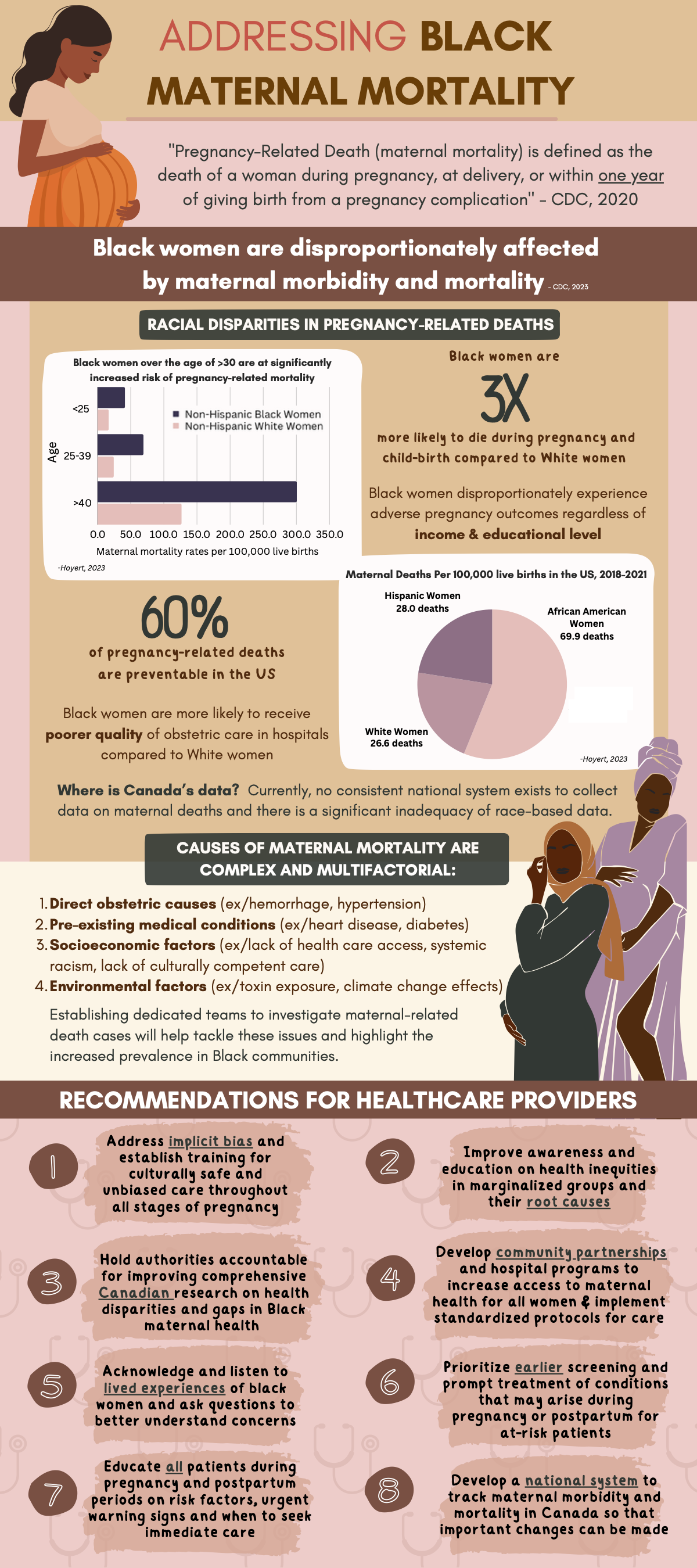Addressing Black Maternal Mortality
DOI:
https://doi.org/10.15273/hpj.v4i1.11991Palavras-chave:
black women, maternal, race-basedResumo
Increasing rates of maternal morbidity and mortality is a growing concern in many industrialized countries. Data from US maternal mortality review committees indicate that more than 80% of these deaths are preventable (Trost et al., 2019). Various factors contributing to this issue include advancing maternal age, increased adults living with congenital disease that may affect outcomes and increased prevalence of comorbidities such as diabetes and hypertension (Fink et al., 2023). In the United States, black women are disproportionately affected by maternal mortality and severe maternal morbidity, facing rates almost three times higher than those of white women (Hoyert, 2023). Few Canadian studies exist, but they echo similar findings. Research by McKinnon and colleagues (2016) found that Black women were more likely to have premature babies and have their pain experiences discounted. A more recent qualitative study based in Toronto reported pervasive obstetric racism experienced by Black women (Boakye et al., 2023). These disparities stem from a complex interplay of factors, including systemic racism, socio-economic disparities, and unequal access to quality healthcare. Unfortunately, research on Black maternal mortality and morbidity is limited in Canada, and we lack a much-needed national system to track these outcomes. Unlike the United States, few Canadian health agencies collect racial statistics. However, disaggregated race-based data is critical for informing targeted interventions and policy changes. This infographic was created under the umbrella of The Newcomer Health Hub, a Canadian medical student-run organization that seeks to increase awareness of health-care disparities in order to improve medical training. Infographics play a crucial role in enhancing comprehension, increasing engagement, and promoting health literacy. Together, through education, advocacy, and community engagement, we can work towards ensuring that every mother receives the support, resources, and care they need to have a safe and healthy pregnancy and childbirth experience, regardless of race or ethnicity.
Referências
Boakye, P. N., Prendergast, N., Bandari, B., Anane Brown, E., Odutayo, A. A., & Salami, S. (2023). Obstetric racism and perceived quality of maternity care in Canada: Voices of Black women. Women's Health, 19. https://doi.org/10.1177/1745505723119965
Centers for Disease Control and Prevention. (2023, April 3). Working Together to Reduce Black Maternal Mortality. US Office of Health Equity. https://www.cdc.gov/healthequity/features/maternal-mortality/index.html
Cortés, Y. I., & Breathett, K. (2021). Addressing inequities in cardiovascular disease and maternal health in black women. Circulation: Cardiovascular Quality and Outcomes, 14(2). https://doi.org/10.1161/CIRCOUTCOMES.121.007742
Creanga, A. A., Berg, C. J., Syverson, C., Seed, K., Bruce, F. C., & Callaghan, W. M. (2015). Pregnancy-related mortality in the United States, 2006–2010. Obstetrics & Gynecology, 125(1), 5-12. https://doi.org/10.1097/AOG.0000000000000564
Fink, D. A., Kilday, D., Cao, Z., Larson, K., Smith, A., Lipkin, C., ... & Rosenthal, N. (2023). Trends in Maternal Mortality and Severe Maternal Morbidity During Delivery-Related Hospitalizations in the United States, 2008 to 2021. JAMA Network Open, 6(6). https://doi.org/10.1001/jamanetworkopen.2023.17641
Hoyert DL. (2023). Maternal mortality rates in the United States, 2021. NCHS Health E-Stats. https://dx.doi.org/10.15620/cdc:124678
McKinnon, B., Yang, S., Kramer, M. S., Bushnik, T., Sheppard, A. J., & Kaufman, J. S. (2016). Comparison of black–white disparities in preterm birth between Canada and the United States. Cmaj, 188(1), E19-E26. https://doi.org/10.1503/cmaj.150464
Trost, S., Beauregard, J., Chandra, G., Njie, F., Berry, J., Harvey, A., & Goodman, D. A. (2022). Pregnancy-related deaths: data from maternal mortality review committees in 36 US states, 2017–2019. Education, 45(10), 1-0.

Downloads
Ficheiros Adicionais
Publicado
Edição
Secção
Licença
Direitos de Autor (c) 2024 Lotus Alphonsus

Este trabalho encontra-se publicado com a Creative Commons Atribuição-NãoComercial 4.0.
The journal aims to reduce barriers to publishing and sharing research and inequalities to accessing information.This journal provides immediate open access to its content on the principle that making research freely available to the public supports a greater global exchange of knowledge. The open-access nature of the journal means that there will be no charge for authors or readers to use the journal. The journal has a Creative Commons Attribution Non-Commercial (CCBYNC) attribution which allows the author (and others) to share and distribute their full-text article in other public domains, such as Google Scholar or Research Gate.
